英语语法一般现在时归纳总结
- 格式:doc
- 大小:68.50 KB
- 文档页数:10
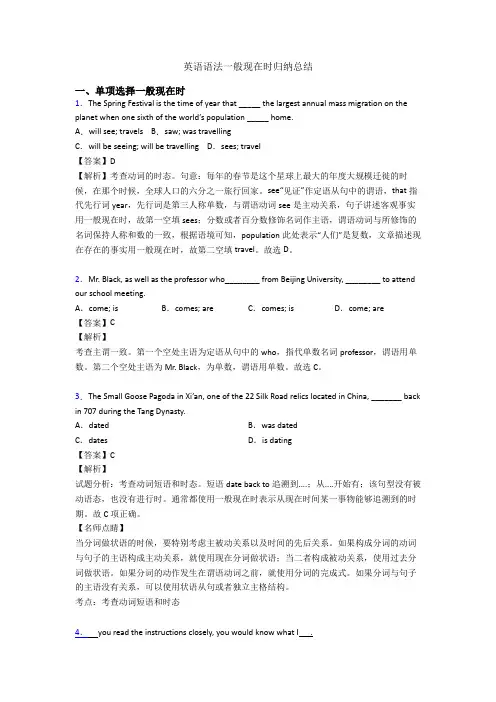
英语语法一般现在时归纳总结一、单项选择一般现在时1.The Spring Festival is the time of year that _____ the largest annual mass migration on the planet when one sixth of the world’s population _____ home.A.will see; travels B.saw; was travellingC.will be seeing; will be travelling D.sees; travel【答案】D【解析】考查动词的时态。
句意:每年的春节是这个星球上最大的年度大规模迁徙的时候,在那个时候,全球人口的六分之一旅行回家。
see“见证”作定语从句中的谓语,that指代先行词year,先行词是第三人称单数,与谓语动词see是主动关系,句子讲述客观事实用一般现在时,故第一空填sees;分数或者百分数修饰名词作主语,谓语动词与所修饰的名词保持人称和数的一致,根据语境可知,population此处表示“人们”是复数,文章描述现在存在的事实用一般现在时,故第二空填travel。
故选D。
2.Mr. Black, as well as the professor who________ from Beijing University, ________ to attend our school meeting.A.come; is B.comes; are C.comes; is D.come; are【答案】C【解析】考查主谓一致。
第一个空处主语为定语从句中的who,指代单数名词professor,谓语用单数。
第二个空处主语为Mr. Black,为单数,谓语用单数。
故选C。
3.The Small Goose Pagoda in Xi’an, one of the 22 Silk Road relics located in China, _______ back in 707 during the Tang Dynasty.A.dated B.was datedC.dates D.is dating【答案】C【解析】试题分析:考查动词短语和时态。
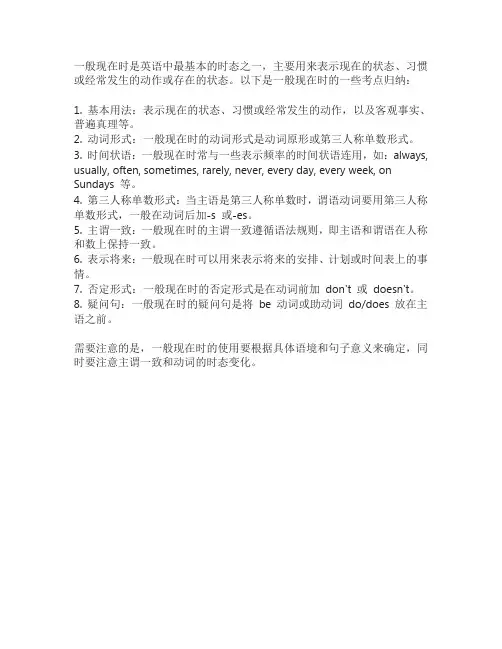
一般现在时是英语中最基本的时态之一,主要用来表示现在的状态、习惯或经常发生的动作或存在的状态。
以下是一般现在时的一些考点归纳:
1. 基本用法:表示现在的状态、习惯或经常发生的动作,以及客观事实、普遍真理等。
2. 动词形式:一般现在时的动词形式是动词原形或第三人称单数形式。
3. 时间状语:一般现在时常与一些表示频率的时间状语连用,如:always, usually, often, sometimes, rarely, never, every day, every week, on Sundays 等。
4. 第三人称单数形式:当主语是第三人称单数时,谓语动词要用第三人称单数形式,一般在动词后加-s 或-es。
5. 主谓一致:一般现在时的主谓一致遵循语法规则,即主语和谓语在人称和数上保持一致。
6. 表示将来:一般现在时可以用来表示将来的安排、计划或时间表上的事情。
7. 否定形式:一般现在时的否定形式是在动词前加don't 或doesn't。
8. 疑问句:一般现在时的疑问句是将be 动词或助动词do/does 放在主语之前。
需要注意的是,一般现在时的使用要根据具体语境和句子意义来确定,同时要注意主谓一致和动词的时态变化。
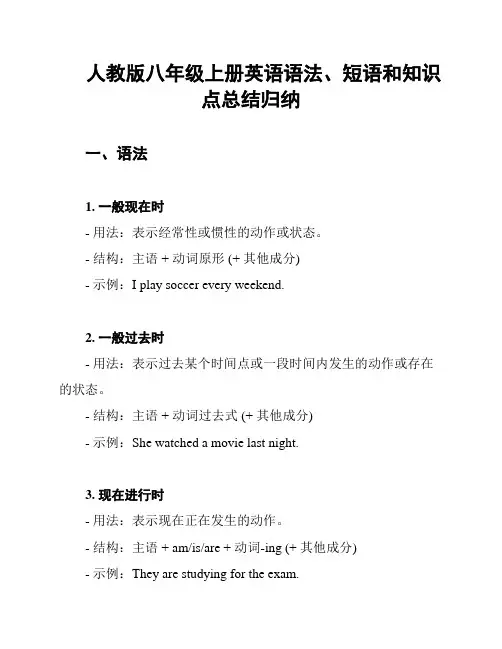
人教版八年级上册英语语法、短语和知识点总结归纳一、语法1. 一般现在时- 用法:表示经常性或惯性的动作或状态。
- 结构:主语 + 动词原形 (+ 其他成分)- 示例:I play soccer every weekend.2. 一般过去时- 用法:表示过去某个时间点或一段时间内发生的动作或存在的状态。
- 结构:主语 + 动词过去式 (+ 其他成分)- 示例:She watched a movie last night.3. 现在进行时- 用法:表示现在正在发生的动作。
- 结构:主语 + am/is/are + 动词-ing (+ 其他成分)- 示例:They are studying for the exam.4. 现在完成时- 用法:表示动作或状态发生在过去某个时间点,但与现在有关。
- 结构:主语 + have/has + 动词过去分词 (+ 其他成分)- 示例:I have finished my homework.5. 情态动词- 用法:表示能力、意愿、可能性等。
- 常见的情态动词有 can, could, may, might, must, should, ought to 等。
- 示例:He should go to bed early.二、短语1. as well as- 用法:表示两个事物同时存在或发生。
- 示例:She can speak English as well as Chinese.2. in order to- 用法:为了做某事。
- 示例:They woke up early in order to catch the train.3. by the way- 用法:用于引入一个新的话题或问题。
- 示例:By the way, have you seen the latest movie?三、知识点1. 直接引语和间接引语- 直接引语:用引号括起来的原话。
- 间接引语:将直接引语转述为陈述句或疑问句。
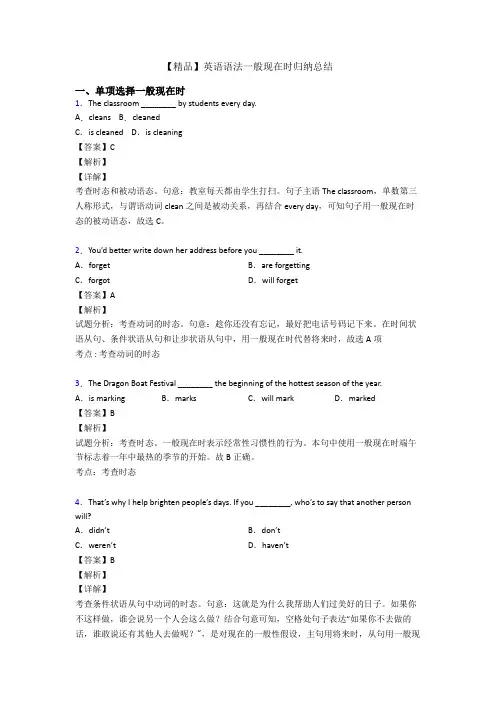

一般现在时的基本概念一般现在时主要用来描述现在的状态、习惯性动作或普遍真理。
就像你每天都会刷牙,这就是一个习惯性动作;太阳每天从东方升起,这是个普遍真理。
构成方式1.肯定句:o主语 + 动词原形 (如果主语是第三人称单数,即he, she, it,需要在动词后加s或es)o例如:I play basketball. 他玩篮球。
He plays basketball.2.否定句:o主语 + do/does + not + 动词原形o例如:I do not (don't) play basketball. 他不玩篮球。
He does not(doesn't) play basketball.3.疑问句:o Do/Does + 主语 + 动词原形?o例如:Do you play basketball? 他玩篮球吗?Does he play basketball?特殊动词形式1.动词结尾是s、sh、ch、x、o的词,加es:o例如:go → goes, watch → watches, fix → fixes2.以辅音字母+y结尾的动词,变y为i再加es:o例如:study → studies, fly → flies3.其他常规动词直接加s:o例如:play → plays, read → reads例子1.习惯动作:o I drink coffee every morning. (我每天早上喝咖啡。
)o She goes to the gym every day. (她每天去健身房。
)2.普遍真理:o Water boils at 100 degrees Celsius. (水在100摄氏度沸腾。
)o The earth orbits the sun. (地球绕太阳公转。
)3.固定安排:o The train leaves at 6 PM. (火车下午6点开。
)o The meeting starts at 9 AM. (会议上午9点开始。
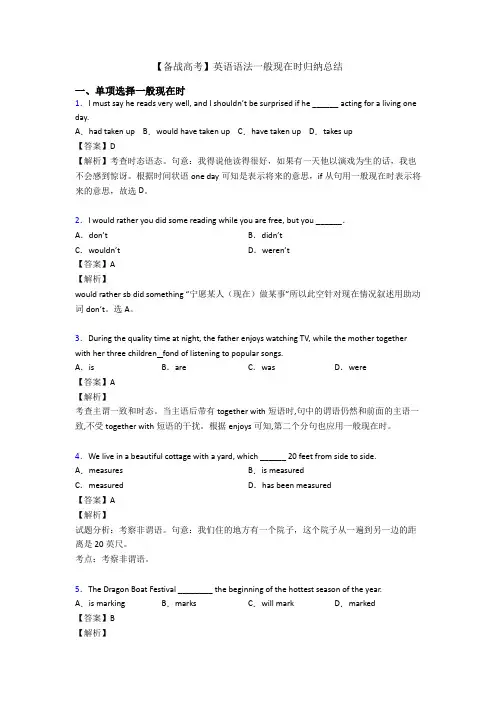
【备战高考】英语语法一般现在时归纳总结一、单项选择一般现在时1.I must say he reads very well, and I shouldn’t be surprised if he ______ acting for a living one day.A.had taken up B.would have taken up C.have taken up D.takes up【答案】D【解析】考查时态语态。
句意:我得说他读得很好,如果有一天他以演戏为生的话,我也不会感到惊讶。
根据时间状语one day可知是表示将来的意思,if从句用一般现在时表示将来的意思,故选D。
2.I would rather you did some reading while you are free, but you ______.A.don’t B.didn’tC.wouldn’t D.weren’t【答案】A【解析】would rather sb did something “宁愿某人(现在)做某事”所以此空针对现在情况叙述用助动词don’t。
选A。
3.During the quality time at night, the father enjoys watching TV, while the mother together with her three children fond of listening to popular songs.A.is B.are C.was D.were【答案】A【解析】考查主谓一致和时态。
当主语后带有together with短语时,句中的谓语仍然和前面的主语一致,不受together with短语的干扰。
根据enjoys可知,第二个分句也应用一般现在时。
4.We live in a beautiful cottage with a yard, which ______ 20 feet from side to side. A.measures B.is measuredC.measured D.has been measured【答案】A【解析】试题分析:考察非谓语。
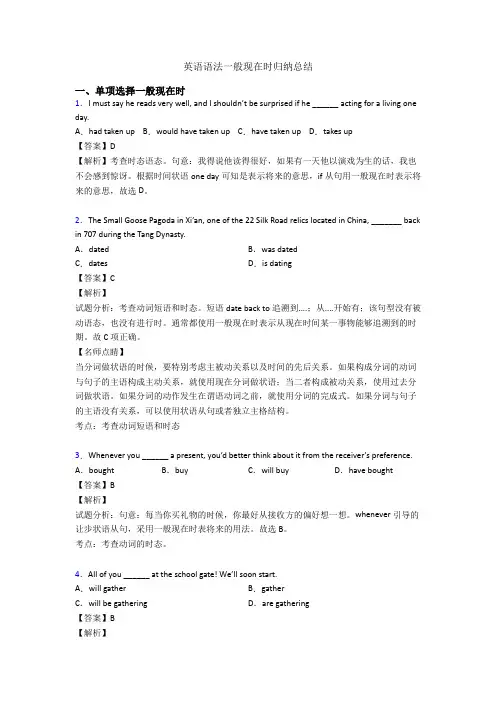
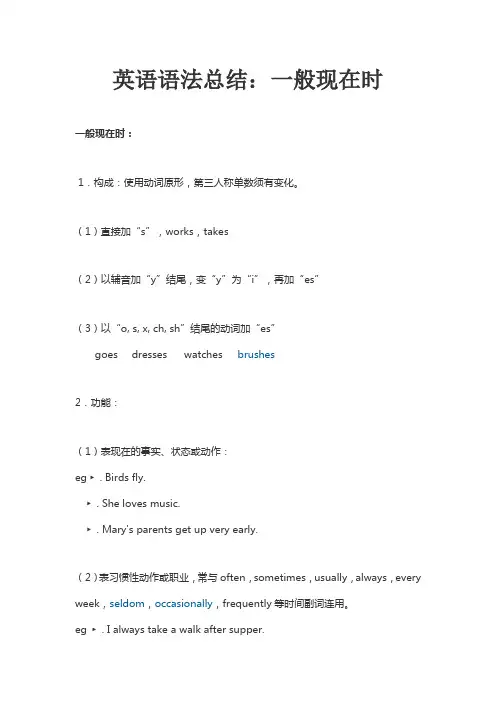
英语语法总结:一般现在时一般现在时:1.构成:使用动词原形,第三人称单数须有变化。
(1)直接加“s”,works,takes(2)以辅音加“y”结尾,变“y”为“i”,再加“es”(3)以“o, s, x, ch, sh”结尾的动词加“es”goes dresses watches brushes2.功能:(1)表现在的事实、状态或动作:eg ►. Birds fly.►. She loves music.►. Mary's parents get up very early.(2)表习惯性动作或职业,常与often,sometimes,usually,always,every week,seldom,occasionally,frequently等时间副词连用。
eg ►. I always take a walk after supper.►. She writes to me very often.►. Tom and his girlfriend go out to take a picnic occasionally.(3)表客观真理,格言警句或事实:eg ►. The earth moves round the sun.►. The sun rises in the east and sets in the west.►. Two and two makes four.►. No man but errs. 人非圣贤,熟能无过。
(4)表将来:A.在由when,after, before,as,as soon as,although,because,if,even if,in case,till,until,unless,so long as,where,whatever,wherever 等引导的状语从句中用一般现在时表将来发生的动作。
(黄金重点,所有考试都不放过它!)eg ►. I'll tell her when she comes tomorrow.►. Even if it rains this afternoon, I'll meet you.►. Whatever happens, you should keep cool-headed. (不错的句型,背下!!)►. I'll be right here waiting for you wherever you go.(很感人的句型!)B.按时间表示将要发生的动作或事件,用一般现在时表达将来时概念。
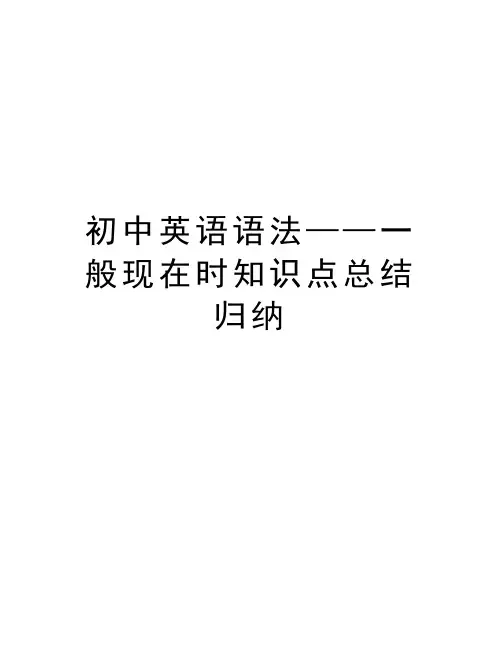
初中英语语法——一般现在时知识点总结归纳初中英语语法——一般现在时知识点总结归纳一般现在时——表示一般性,经常性的动作或一般性事实。
概念:表示经常发生的动作或经常存在的状态。
常和 always , often , usually , sometimes , every day 等表时间的状语连用。
如:1) I go to school every day . 我每天都去学校。
(表经常)2) He is always like that . 他总是那样。
(表状态)构成:1) 主语 + be (am / are / is ) +……2) 主语 + 实义动词/三单动词+ …【解析】1、含有be动词的句子He is a teacher.The girl is very beautiful.Tim and Jack are students.★变疑问句将be动词移到句首Is he a teacher?Is the girl very beautiful?Are Tim and Jack students?★变否定句在be动词后面加notHe is not a teacher.The girl is not very beautiful.Tim and Jack are not students.★肯定回答及否定回答Yes, he is. / No, he is not.Yes, she is. / No, she is not.Yes, they are. / No, they are not.2、不含有be动词的句子,即含有一般动词的句子。
(1)第三人称单数及单数名词He likes books.She likes him.The dog likes bones.★变疑问句在句首加does, 动词变为原型Does he like books?Does she like him?Does the dog like bones?★变否定句在主语及动词之间加doesn't, 动词变为原型,原句中的动词不再有第三人称变化。
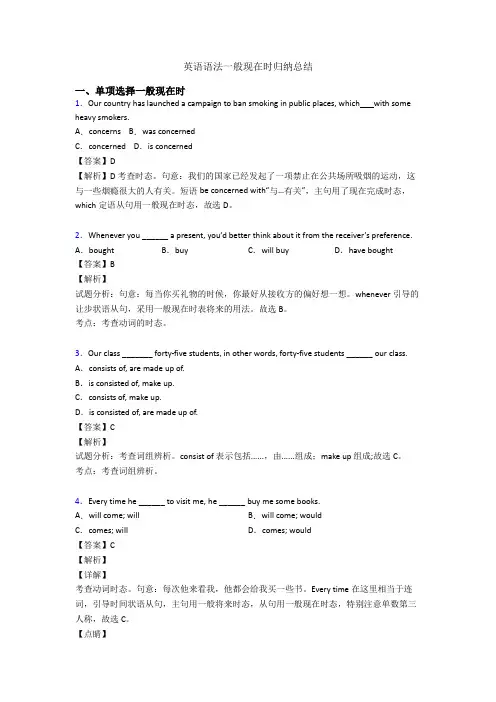
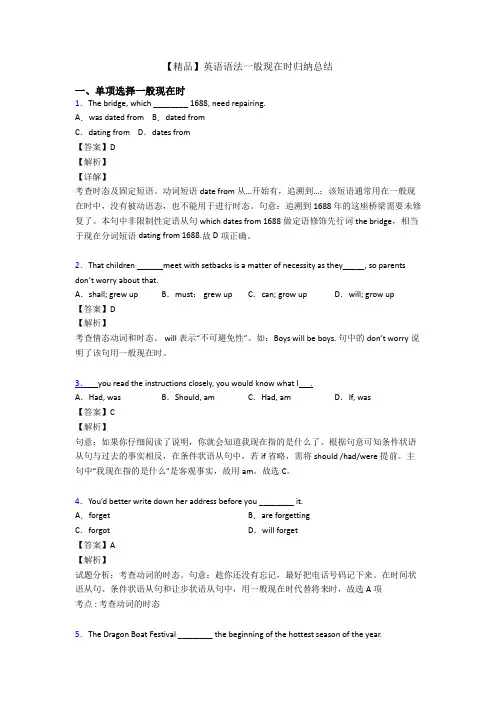
初中英语语法总结一般现在时一般现在时是英语中最常用的时态之一,用来表达经常或习惯性发生的动作、现实存在的情况、普遍真理等。
以下是初中英语语法总结一般现在时的重点内容:1.基本用法:- 表示经常性或习惯性动作:I usually go to school by bus.(我通常乘公交车去上学。
)- 表示现实存在的情况:She lives in London.(她住在伦敦。
)- 表示普遍真理:Water boils at 100 degrees Celsius.(水在100摄氏度烧开。
)2.句子结构:- 肯定句:主语 + 动词原形 + 其他。
I like to play basketball.(我喜欢打篮球。
)- 否定句:主语 + do not / does not + 动词原形 + 其他。
He does not like to eat vegetables.(他不喜欢吃蔬菜。
)- 疑问句:Do / Does + 主语 + 动词原形 + 其他?Do you play soccer?(你踢足球吗?)3.第三人称单数:- 在第三人称单数主语(he,she,it)中,动词要加-s或-es,否定句和疑问句中需用 does。
He watches TV every evening.(他每晚看电视。
)- 一些以s, sh, ch, x, o结尾的单词,需要在动词后加-es,如:misses,washes,watches。
4.频率副词:- 频率副词通常放在动词之前,用于修饰动词。
例如:She always helps others.(她总是帮助别人。
)5.现在进行时与一般现在时的区别:- 现在进行时表示现在正在发生的动作,一般与现在时间状语连用,或表示现阶段的临时情况。
例如:I am studying for the exam.(我正在准备考试。
- 一般现在时表示经常性、习惯性的动作或客观存在的状态。
例如:I usually play soccer on weekends.(我通常在周末踢足球。
一般现在时一、[概念]表示经常性或习惯性的动作或状态。
常与often(经常), always(总是),usually(通常), every day(每天), sometimes(有时)等时间状语连用。
如:We speak Chinese every day.我们每天都讲汉语。
一般现在时还用于表达客观真理,科学事实。
例: Three and four makes seven.表示格言或警句中。
Pride goes before a fall. 骄者必败表示现在的状态、性格、个性。
例:1)I don’t want more, thanks.2)He is a good student. He is always ready to help others在when, until, before, if等从属连词引导的状语从句里,主句用将来时态,从句用一般现在时I shall come to help you if I am free tomorrow.只用于一般现在时的表示状态和感觉的动词Be, love, like, want, hope, suppose, need, prefer wish, know, find, feel, understand, believe, guess, hear二、一般现在时的动词有两种形式,下面分别讲述一般现在时动词be和 have的变化形式1.连系动词be的用法:除了第一人称单数用am,和第三人称单数用is以外,其它人称用are。
eg:1)I am busy. You are busy. 2)He (She) is busy.3)We (You, They) are busy.2.动词have的用法:除了第三人称单数用has以外,其它人称一律用have。
eg:1)I have a pen. 2)You have a pen.3)She (He) has a pen. 4)We (You, They) have pens.一般现在时行为动词词型变化形式一般现在时动词只有第三人称有词形变化,其他人称动词均用原形第三人称单数动词的变化规则如下:1.多数在动词后加s. play—plays like—likes ,say--says2.以s,x,sh,ch,o结尾的动词加es. go—goes wash--washes,3.以辅音字母加y结尾,把y改i再加es. fly—flies study—studies carry—carrieseg: 1)I do my homework every day.2)She often goes to bed late on weekend.三. 一般现在时的句型1.肯定句构成:主语+动词 (注意人称变化) +其它成分例:1)I have a dog. 2)We like the little cat.3)She sings well.2.否定句构成:行为动词的否定句:主语+助动词(do/does) + not +动词原形+其它成分例:1)He dosen’t have a dog. 2)He isn’t young.3)We don’t like the little cat.3.一般疑问句:A.行为动词的一般疑问句:助动词(do/does)+主语+动词原形 + 其它成分1)Do you like it? ---Yes, I do. / No. I don’t .2)Does he(she) like it? ---Yes, he( she )does. / No, he ( she )doesn’t.B. 动词BE 的一般疑问句Am / Is /Are +主语 + 其它成分1)Are you a teacher? -- Yes, I am. / No, I am not.2)Are they students of your school.---Yes they are / No they aren,t.4.特殊疑问句:特殊疑问词 + 一般疑问句1)How many students are there in your school?2)What do you usually do on Sunday?一、写出下列动词的第三人称单数talk______ play______ say______ buy______ worry______ fly______ study_______ like_______ wash_____ watch_______ teach_____ fish_______ reach_______ go_______ do_____二、用括号内动词的适当形式填空。
【备战高考】英语语法一般此刻时概括总结一、单项选择一般此刻时1.I must say he reads very well, and I shouldn’ t be surprised if he ______ acting for a living one day.A. had taken up B. would have taken up C. have taken up D.takes up【答案】D【分析】观察时态语态。
句意:我得说他读得很好,假如有一天他以演戏为生的话,我也不会感觉吃惊。
依据时间状语one day 可知是表示未来的意思,if从句用一般此刻时表示将来的意思,应选D。
2.I would rather you did some reading while you are free, but you ______.A. don ’t B.didn ’tC. wouldn ’t D. weren ’t【答案】 A【分析】would rather sb did something 情愿某人“(此刻)做某事”因此此空针对此刻状况表达用助动词 don’t。
选 A。
3.During the quality time at night, the father enjoys watching TV, while the mother togetherwith her three children fond of listening to popular songs.A. is B. are C. was D. were【答案】A【分析】观察主谓一致和时态。
当主语后带有together with短语时,句中的谓语仍旧和前方的主语一致,不受 together with短语的扰乱。
依据enjoys 可知 ,第二个分句也应用一般此刻时。
4.We live in a beautiful cottage with a yard, which ______ 20 feet from side to side.A. measures B.is measuredC. measured D. has been measured【答案】 A【分析】试题剖析:观察非谓语。